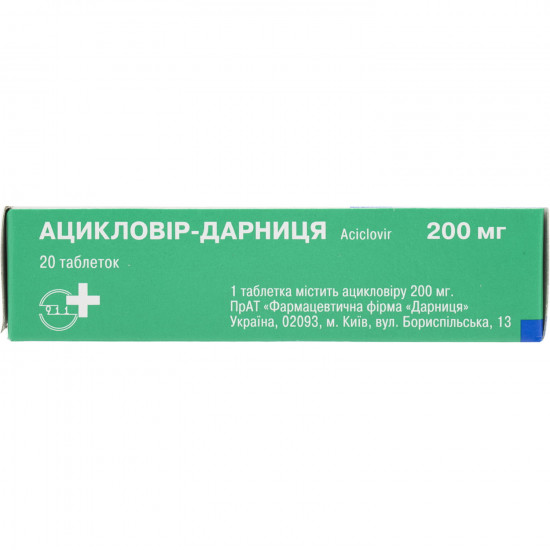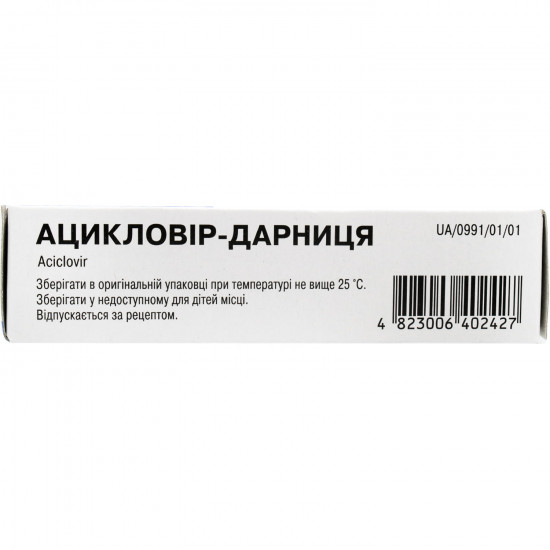





- Stock: In Stock
- Model: 179044
0% Customers recommend this product
-
5 Awesome0%
-
4 Great0%
-
3 Average0%
-
2 Bad0%
-
1 Poor0%
Reviews Over Atsiklovir-Darnitsa tab. of 200 mg No. 20
- (0)
Total Reviews (0)
click here write review to add review for this product.
Report this review.
Description
Pharmacological properties
Pharmacodynamics. acyclovir is a synthetic analog of a purine nucleoside with the inhibiting activity of in Vivo and in vitro concerning a virus of herpes of the person, including a virus of a herpes simplex of i and ii of type, a virus of chicken pox and the surrounding herpes, Epstein's virus — Barre and a cytomegalovirus. in the culture of cages acyclovir shows the greatest activity against a virus of a herpes simplex of i of type and further, on decrease of activity, against a virus of a herpes simplex ii of type, a virus of chicken pox and the surrounding herpes, Epstein's virus — Barre and a cytomegalovirus.
Inhibiting activity of acyclovir against above-mentioned viruses is high-selection. Enzyme the thymidinekinase in the normal not infected cell does not use acyclovir as substrate therefore toxic action concerning cages of an organism owner is minimum. However the thymidinekinase coded in a herpes simplex virus, a virus of chicken pox, the surrounding herpes and Epstein's virus — Barre, turns acyclovir into acyclovir monophosphate — an analog of a nucleoside which then turns consistently into diphosphate and triphosphate by means of cell enzymes. After embedding in virus DNA of acyclovir triphosphate interacts with a virus DNA polymerase what the termination of synthesis of a chain of virus DNA is result of.
At long or repeated courses of treatment of heavy patients with reduced immunity the decrease in sensitivity of separate virus strains which not always respond to treatment with acyclovir is possible. The majority of clinical cases of insensitivity are connected with deficiency of a virus thymidinekinase, however there are messages about damage of a virus thymidinekinase and DNA. In vitro can also lead interaction of separate viruses of a herpes simplex with acyclovir to forming of less sensitive strains. The interdependence between sensitivity of separate viruses of a herpes simplex of in vitro and clinical results of treatment with acyclovir is up to the end not found out.
Pharmacokinetics. Acyclovir is only partially absorbed in a digestive tract (about 20% of the accepted dose). The concomitant use of food does not lead to decrease in absorption. The C max is reached in 1.5-2 h
Level of its linking with proteins of blood plasma rather low (from 9 to 33%) and in interaction with other medicines does not change.
Acyclovir gets through a placental barrier, into SMZh (50% of the corresponding concentration in blood plasma), breast milk.
Majority of medicine (85–90%) is removed in not changed look by kidneys and only an insignificant part (10–15%) — in the form of a metabolite (9-karboksimetoksimetilguanin). The renal clearance of acyclovir is significantly higher than clearance of creatinine that indicates that medicine removal by kidneys is carried out by not only glomerular filtration, and and canalicular secretion.
Final T ½ at in in introduction of acyclovir makes about 2.9 h, patients with HPN have 19.5 h, during a hemodialysis — 5.7 h. Acyclovir level in blood plasma during dialysis decreases approximately by 60%.
Indication
Treatment of infections of skin and the mucous membranes caused by the herpes simple virus including primary and recurrent genital herpes.
Prevention of a recurrence of the infections caused by the Herpes simple virus at patients with normal immunity.
Prevention of the infections caused by the Herpes simple virus at patients with an immunodeficiency.
Treatment of the infections caused by the Varicella zoster virus (chicken pox, the surrounding herpes).
Use
Pill should be taken entirely, washing down with water. at application of high doses of medicine it is necessary to support the adequate level of hydration of an organism.
Adult. Treatment of the infections caused by the Herpes simple virus. To use medicament in a dose 200 mg of 5 times a day with approximately 4-hour interval, except for the night period. Treatment duration — 5 days, but in case of heavy primary infection it can be continued.
If necessary the patient with a heavy immunodeficiency or with reduced absorption in intestines can double a single dose to 400 mg or to apply the corresponding dose for in/in introductions.
Treatment needs to be begun withas soon as possible after the beginning of development of an infection. In case of recurrent herpes it is the best of all to begin treatment during a prodromal stage or after emergence of the first signs of damage of skin.
Prevention of a recurrence of the infections caused by the Herpes simple virus at patients with normal immunity. To use medicament in a dose 200 mg 4 times a day with a 6-hour interval (or for convenience — in a dose of 400 mg 2 times a day with a 12-hour interval).
Treatment will be effective even after a medicine dose decline up to 200 mg 3 times a day with a 8-hour interval or even 2 times a day with a 12-hour interval.
In certain cases radical improvement is noted byafter reception of a daily dose 800 mg.
therapy of medicine needs to be interrupted withFor observation of possible changes of the natural course of a disease periodically with an interval of 6-12 months
Prevention of the infections caused by the Herpes simple virus at patients with an immunodeficiency. To use medicament in a dose 200 mg 4 times a day with a 6-hour interval.
If necessary the patient with a heavy immunodeficiency or with reduced absorption in intestines can double a single dose to 400 mg or to apply the corresponding dose for in/in introductions.
Duration of prevention depends on risk period duration.
Treatment of the infections caused by the Varicella zoster virus. To use medicament in a dose 800 mg of 5 times a day with approximately 4-hour interval, except for the night period. Treatment duration — 7 days.
Treatment needs to be begun withas soon as possible after the beginning of a disease, the result will be better if therapy to begin at once after appearance of rashes. Sick with a heavy immunodeficiency or with reduced absorption in intestines it is better for p to apply
in/in medicine introduction.
Children aged from 2 years. Treatment and prevention of the infections caused by the Herpes simple virus at children with an immunodeficiency. To use medicament in doses, as for adults.
Treatment of chicken pox. To use medicament in a dose: children aged from 2 up to 6 years — 400 mg 4 times a day, children are more senior than 6 years — 800 mg 4 times a day.
More precisely a dose of medicine can be calculated on the body weight of the child — 20 mg/kg of body weight a day, divided into 4 receptions. The maximum daily dose — 800 mg. Treatment duration — 5 days.
or for treatment of the infections caused by a virus of the surrounding herpes at children with normal immunity is not presentSpecial data on use of acyclovir for prevention of the infections caused by a herpes simplex virus.
Patients with a renal failure. To use medicament with care. It is necessary to support the adequate level of hydration of an organism.
recommended oral doses do not leadAt prevention and treatment of the infections caused by the Herpes simple virus at patients with a renal failure to accumulation of acyclovir which level would exceed the safe values established for in/in introductions. However the patient with a heavy renal failure (clearance of creatinine of 10 ml/min.) recommends to use medicament in a dose of 200 mg 2 times a day with approximately with a 12-hour interval.
At treatment of the infections caused by the Varicella zoster virus sick with much reduced immunity is recommended to use medicament in a dose: at a heavy renal failure (clearance of creatinine of 10 ml/min.) — 800 mg 2 times a day with approximately 12-hour interval, at a moderate renal failure (clearance of creatinine within 10–25 ml/min.) — 800 mg 3 times a day with approximately 8-hour interval.
Patients of advanced age. To use medicament with care. It is necessary to support the adequate level of hydration of an organism.
Should mean a possibility of a renal failure at patients of advanced age, and the medicine dose for them needs to be changed respectively.
Contraindication
Hypersensitivity to acyclovir, a valatsiklovir or other components of medicine.
Side effects
from a cardiovascular system: heart consciousness, thorax pain.
from the system of blood and lymphatic system: anemia, leukopenia, thrombocytopenia.
from nervous system and mentality: headache, dizziness, psychomotor arousing, confusion of consciousness, tremor, ataxy, dysarthtia, hallucinations, psychotic symptoms, spasms, drowsiness, encephalopathy, coma.
Above-mentioned symptoms are in most cases reversibleand arise mainly at patients with a renal failure or other risk factors (see. Special INSTRUCTIONS).
from the respiratory system, bodies of a thorax and mediastinum: short wind.
from a digestive tract: nausea, vomiting, diarrhea, abdominal pain, loss of appetite, gastritis, dysphagy.
from a gepatobiliarny system: tranzitorny increase in activity of enzymes of a liver and level of bilirubin, jaundice, hepatitis.
from an urinary system: increase in concentration of urea and creatinine in blood, OPN, pain in kidneys. Pain in kidneys can be connected with a renal failure and a crystalluria.
from the immune system, leather and hypodermic cellulose: reactions of hypersensitivity, including rash, itch, hyperaemia, urticaria, Quincke's disease, anaphylactic reactions; photosensitization, alopecia.
As the hair loss can be connected bywith a large number of diseases and administration of drugs, accurate connection with use of acyclovir is not established.
General violations: fatigue, fever.
Special instructions
should support byAt application of high doses of medicine the adequate level of hydration of an organism.
to use Drug with care at patients with a renal failure as acyclovir is removed from an organism mainly by kidney clearance. It is necessary to carry out dose adjustment (see USE).
to use Drug with care at patients of advanced age as this group of patients has a high probability of a renal failure. In case of need it is necessary to carry out dose adjustment (see USE).
Both of these groups (patients with a renal failure and patients of advanced age) are risk groups on emergence of neurologic violations and therefore they have to be under fixed control for identification of these side reactions. On the obtained data, such tests are in general reversible in case of the treatment termination (see. Side EFFECTS).
Use during pregnancy and feeding by a breast. During the post-registration period of observation of pregnant women results of application for pregnant various pharmaceutical forms of acyclovir are documented. Increase in amount of congenital defects at children whose mothers applied acyclovir during pregnancy, in comparison with the general population is not revealed.
At oral administration of acyclovir in a dose of 200 mg of 5 times a day it gets into breast milk in the concentration making 0.6-4.1% of appropriate level of acyclovir in blood plasma. Potentially the child can receive acyclovir in a dose to 0.3 mg/kg of body weight a day.
during pregnancy and feeding by a breast to use medicament when its potential advantage for mother exceeds possible risk for a fruit.
Children. To use medicament at children aged from 2 years.
Ability to influence speed of response at control of vehicles or work with other mechanisms. Clinical trials of influence of acyclovir on speed of response at control of vehicles or work with other mechanisms it was not carried out. The pharmacology of acyclovir does not give the grounds to expect any negative impact. At the solution of a question of a possibility of driving and other mechanisms it is necessary to take the clinical status of the patient and a profile of side reactions of medicine into account.
Acyclovir is emitted to
Interaction
mainly in not changed look with kidneys by canalicular secretion therefore any medicines having the similar mechanism of discharge can increase concentration of acyclovir in blood plasma.At simultaneous application with other medicines perhaps:
with probenetsidy, Cimetidinum — lengthening of T ½ acyclovir and AUC;
with immunosuppressants at patients after organ transplantation — increase in level of acyclovir and an inactive metabolite of immunosuppressive medicine in blood plasma, taking into account the wide therapeutic index of acyclovir of need for dose adjustment is not present.
byClinically important interaction of acyclovir with other medicines it is not revealed.
Overdose
Symptoms. acyclovir is only partially absorbed in a digestive tract. it was reported about cases of inadvertent reception by patients up to 20 g of acyclovir without emergence of toxic effect.
At accidental overdose of the acyclovir accepted inside within several days the following symptoms arise: gastroenterological (nausea, vomiting) and neurologic (headache, confusion of consciousness).
At overdose entered in/in acyclovir creatinine level in blood plasma, urea nitrogen in blood increases and, respectively, the renal failure develops. The confusion of consciousness, a hallucination, excitement, spasms and a coma can be neurologic manifestations of overdose.
Treatment: it is necessary to examine the patient for identification of symptoms of intoxication, to carry out symptomatic therapy, in hard cases — a hemodialysis.
Storage conditions
In original packing at a temperature not above 25 °C.
Specifications
| Characteristics | |
| Active ingredients | Acyclovir |
| Amount of active ingredient | 200 mg |
| Applicant | Darnitsa |
| Code of automatic telephone exchange | J05AB01 Acyclovir |
| Interaction with food | It doesn't matter |
| Light sensitivity | Not sensitive |
| Market status | Generic-generic |
| Origin | Chemical |
| Prescription status | According to the prescription |
| Primary packing | blister |
| Producer | DARNITSA CIAO PHARMACEUTICAL. FIRM |
| Quantity in packing | 20 tablets (2 blisters on 10 pieces) |
| Release form | tablets for internal use |
| Route of administration | Oral |
| Sign | Domestic |
| Storage temperature | from 5 °C to 25 °C |
| Trade name | Acyclovir |














































